The clash between two teams who were at both ends of the table usually ended up with a convincing win for the higher-rated team. That was the expectation of both Dijon and Paris Saint-Germain fans before heading into their clash on matchday twelve of Ligue 1.
For the home side, they were never considered as favourites for this match looking at their record this season. With only two wins and three draws, Dijon sat at the bottom of the league table and many expected them to involve in the relegation battle. In contrast, though, their last five matches showed something different as they drew against both Lyon and Marseille while secured two wins over Strasbourg and Stade Reims.
Meanwhile, Paris Saint-Germain enjoyed a dominant spell as expected with nine wins since the start of the season. Still, their second loss against Reims showed there were more things that Thomas Tuchel’s side needed to improve. After four matches which saw them secured a total of twelve points out of twelve, their weaknesses were showed once again as two goals from Mounir Chouiar and Jhonder Cádiz helped Dijon climbed out of the relegation zone.
This tactical analysis will provide an analysis of Dijon’s 2-1 win over Paris Saint-Germain. Meanwhile, using statistics, we will point out what went wrong for Tuchel’s tactics against Stéphane Jobard’s tactics.
Lineups
Tuchel’s side entered this match lining his side up in their familiar 4-1-2-3 formation. The German manager had a handful of key players who absented through injuries, such as Thomas Meunier. The Belgian right-back remained on the sideline as his position was replaced by Colin Dagba in recent matches.
Alongside that, versatile defender Thilo Kehrer also missed out as he still recovered from his injury. This gave Presnel Kimpembe and Marquinhos the chance to pair up at the heart of PSG’s defence, while Abdou Diallo occupied the left-hand side with Kylian Mbappé playing in front of him.
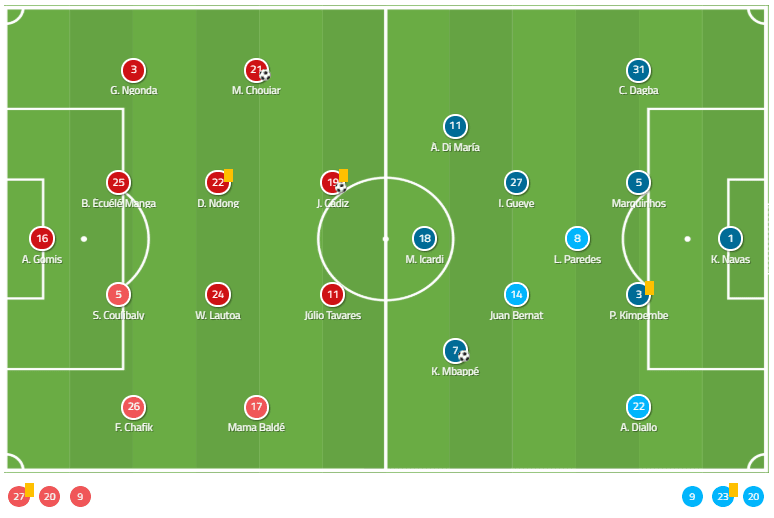
On the opposite side, Jobard was lucky enough to have every player fit to choose for his 4-4-2 formation. New signing Alfred Gomis was chosen to start in goal as Senou Coulibaly and another fresh face in Bruno Ecuélé Manga screened in front of him.
Occupying the central midfield spots were former Sunderland midfielder Didier Ndong and Wesley Lautoa, who spent time playing with Ndong when they were at Lorient. Up front, Júlio Tavares and Jhonder Cádiz took on the responsibility of scoring goals while Mama Baldé and Mounir Chouiar occupied both wings.
Dijon’s style of play
Being an underdog in this match, Dijon didn’t show the intention of sitting back and defending the box. In their 4-4-2 formation, the players formed two distinctive defensive lines and even positioned themselves in the central area of their own half. They aimed to stretch their shape fairly wide to occupy both the central area and the half-spaces.
Acknowledging that PSG tended to play out from the back, they opted to use this strategy as it allowed them to capitalise on chances which could disrupt the opposition’s build-up. Furthermore, congesting the central area would force the defenders to distribute the ball wide more often. They dealt with this by shifting their shape horizontally across the pitch to create overloads wherever the ball came to.
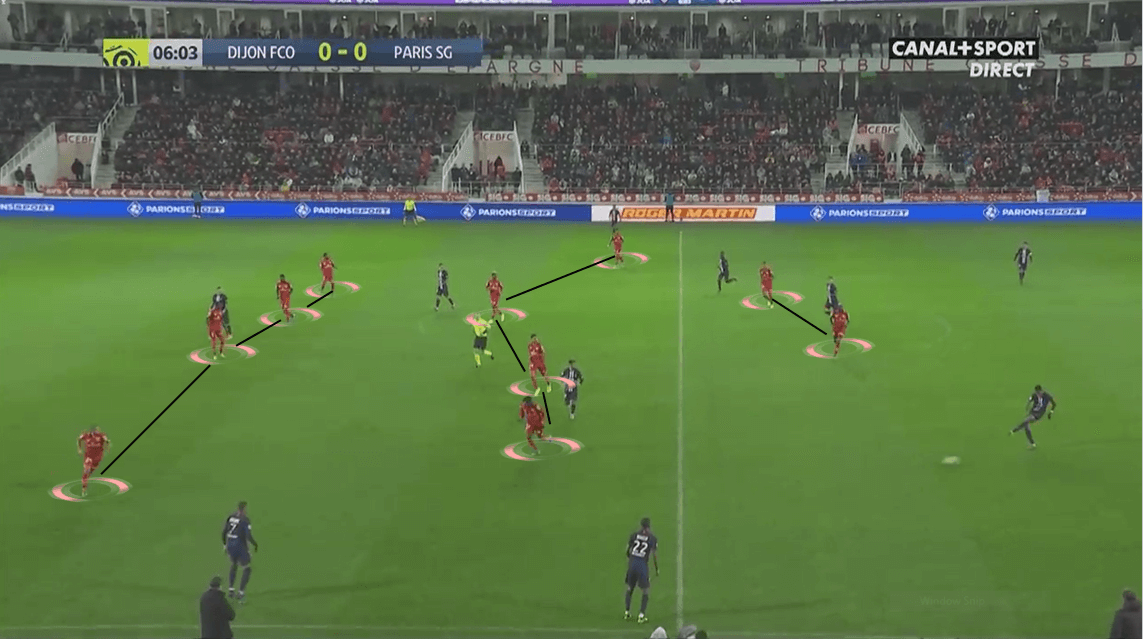
Playing against a team who had such strong attacking quality, it was important that the players remained disciplined to eliminate possible gaps that can be exploited, especially the defenders. Since they were the last line of the defence, they needed to be aware of potential movements from Mauro Icardi and Kylian Mbappé as they had the ability to attack the space behind the line.
At the same time, the midfielders were also required to drop deep and narrowed the gap between them and the defenders. This prevented the opposition from distributing the ball between the lines and from there, made through balls to the attackers and allowed them to sprint towards the box.
But at times, though, having a narrow defensive shape could invite the attacking full-backs to make overlapping runs more often. This seemed to be the case for Dagba and Bernat as they constantly drifted wide to receive long balls from the midfielders, similar to the shot below. As they usually turned up at the other end of passes, PSG had more opportunities to approach the 16-yard box from out wide.
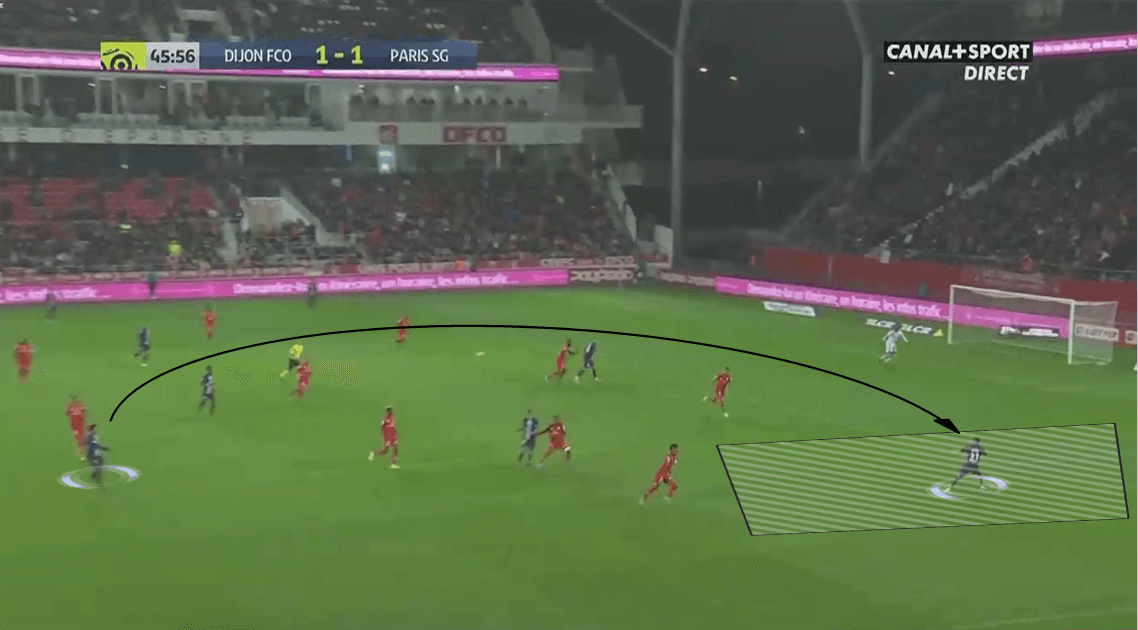
With both Ngonda Muzinga and substitute Hamza Mendyl tended to push high up the pitch, they left the space behind their back unoccupied. The two centre-backs couldn’t move wide as it could lead to Icardi had more space to work inside. Therefore, Dijon lacked players during a few of PSG’s counter-attacks which allowed the visitors to approach the ball in a more efficient way.
When on possession, though, the home side created some serious chances and reached a higher efficiency rate compared to PSG. One of the method that the home side used to progress the ball into the final third was through long balls. In Tavares and Cádiz, they had two target man who had the physicality to shield the ball and then laid off to their teammates.
Another noticeable point in how they played was one would usually drop from his position to receive the ball and the other moved into the space that was created. This strategy was used to lure one of the PSG defenders out of their defensive line, and at the same time, allowed Dijon players to attack the space behind the line. The players who made the run would attempt to beat his marker and turned up at the end of the through ball. During the match, Tavares was the player who involved heavily in this scenario type as he usually became the focal point for his teammates, as shown in the shot below.
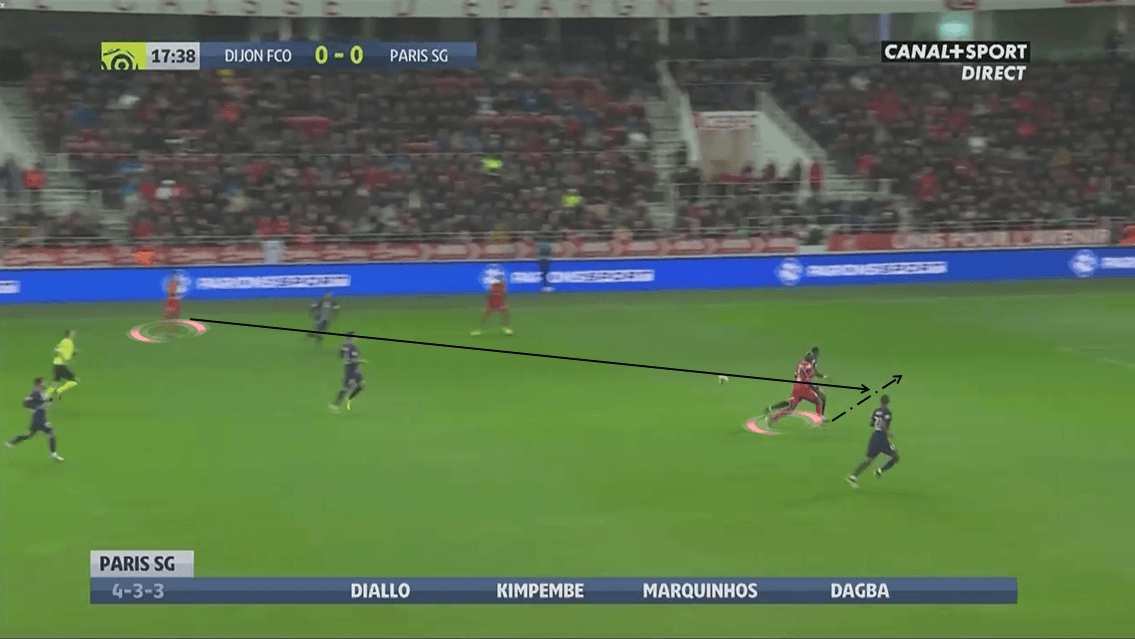
In the above situation, it is easy to notice that there was space created inside PSG’s defensive third. It invited Dijon’s attackers to move in and connected with the attacking sequence. This didn’t happen once in the match, as shown in Cádiz’s goal in the second half.
During an open play situation, the visitors opted to commit numbers to the flank and attempted to nick the ball away from the Dijon striker while eliminating the option of a back pass towards Chouiar. Although there was heavy pressure being applied on Cádiz, he managed to get away and entered the area where no one was occupied. Furthermore, if he decided to pass the ball, there would be two available options in Ngonda and Ndong, who were also unmarked.
But, since this was a great chance for him to get his name on the scoresheet, dribbling on his own was his option. While he entered the box, Idrissa Gueye caught up with him while Leandro Paredes, Marquinhos and Kimpembe were ready to close him down. None of them managed to prevent the ball went into the back of the net, though. It was somewhat a lucky shot for Cádiz as the ball went through Keylor Navas’ leg but it showed the lack of spatial awareness of PSG players to close the gap down.
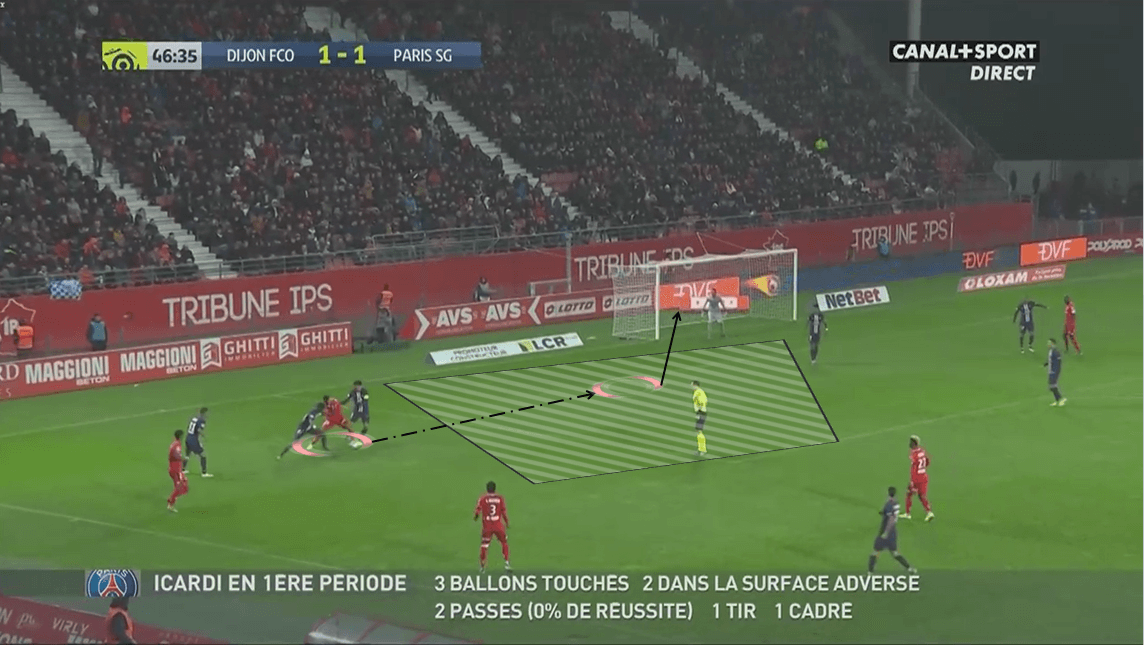
Paris Saint-Germain’s style of play
During most of the first half, PSG were the team who dominated the game. In possession, they tended to put an emphasis on playing out from the back using the passing ability of their centre-backs Kimpembe and Marquinhos. They were the key players during this process as they took on the responsibility of distributing the ball up the field for the central midfielders.
In Paredes and Gueye, PSG had two dynamic midfielders who could divide their attacking and defending duties equally. More specifically, though, the former Zenit midfielder would be the team’s main creative source, playing in the role similar to Marco Verratti’s. Gueye was a workhorse who covered much of the field while screening the space in front of the defence. This combination created flexibility in the central area of the field during the team’s transitioning process.
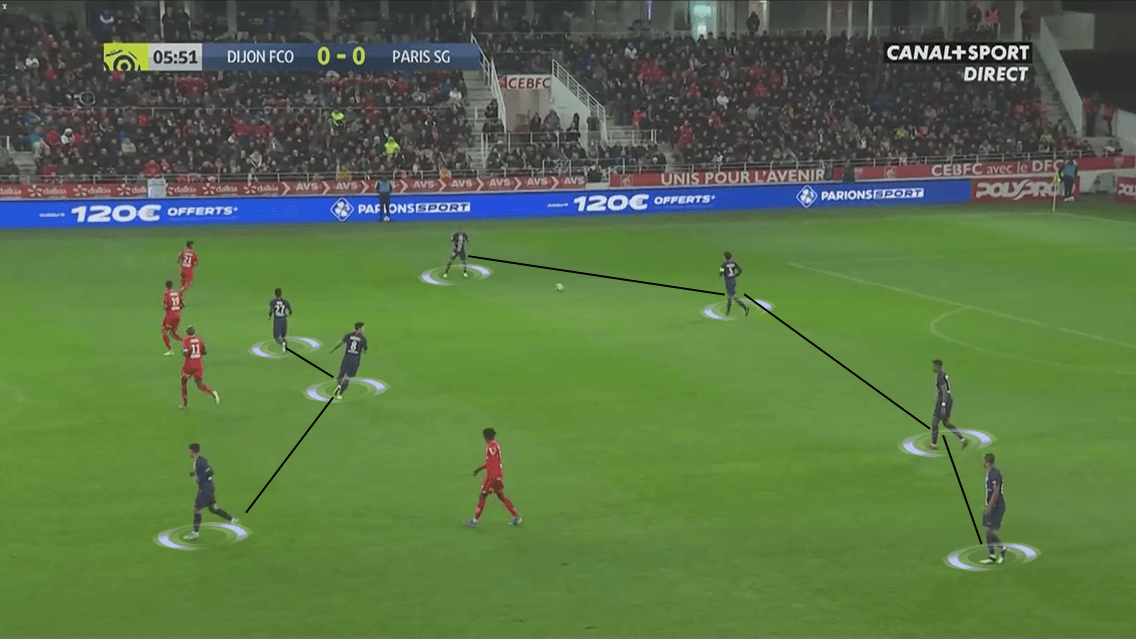
Inside the second half, it was clear to see that Tuchel applied a few minor changes to their build-up scenarios which involved Diallo. With him being a ball-playing defender, the visitors now had three centre-backs who were comfortable on the ball and able to make penetrative passes up the field. Diallo’s involvement in the team’s build-up created a back-three for PSG, allowing Dagba to position himself higher up the field and ready to attack the right-hand side.
Furthermore, notice how Juan Bernat usually drifted wide from his position. Starting off as one of the midfielders, he then moved into a left wing-back during the latter period to provide width for the attack. The pivots remained the same and took on similar works, which one of them was connecting the defenders and the attackers.
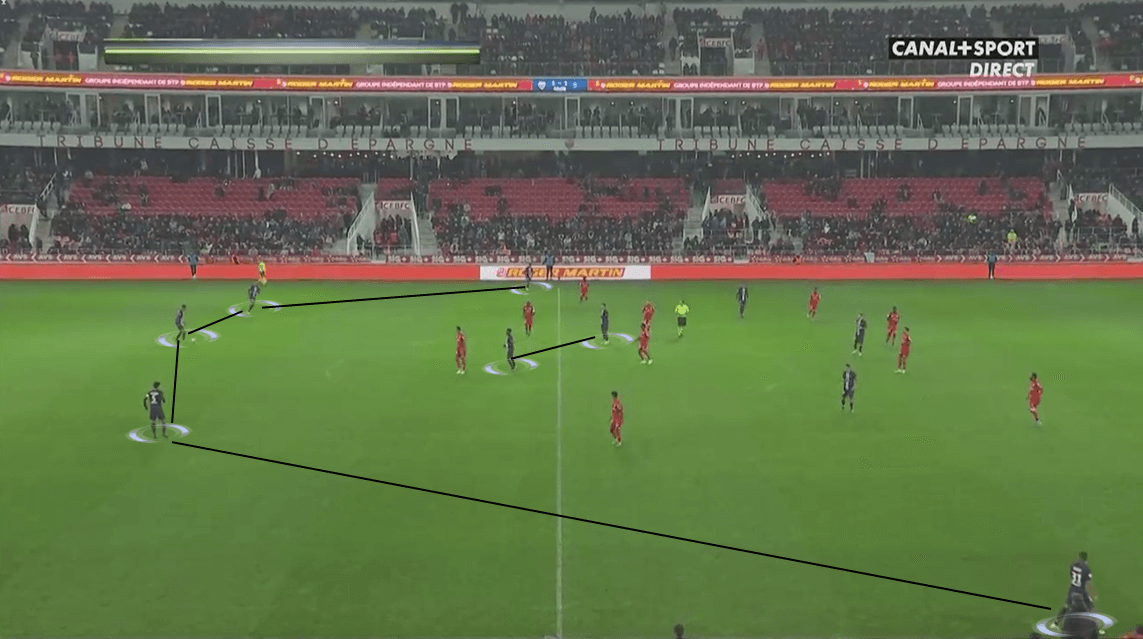
With that in mind, it is no surprise to see PSG dominated possession during the match. They opted to use more short passes to progress the ball up the field and through passes to help the attackers entered the box. Inside the final third, the visitors also relied on crosses since they were a wing-oriented team and distributed the ball out wide for Bernat and Dagba more often.
Having much of the ball also meant it was viable to create more chances. But creating was one thing, converting them was another thing. Although PSG were on the front foot during the majority of the time and registered an overwhelming twenty chances towards Gomis’ goal, they only managed to score one.
The low conversion rate really caused them troubles as only four of their chances managed to hit the target. Gomis’ solid performance was one of the factors contributed to this as he consistently showed his composure and calmness to control the situation. But it only took up a small part in PSG’s problem if we take a look at their shots map.
Firstly, with most of their chances took place inside the box, the attackers should have done better to register more shots on target. Instead, they saw those chances blocked or went wide. Secondly, there were a low number of chances which were highly xG-rated, specifically above 0.1. It contributed to their total xG rating of 1.88, which basically showed that they performed exactly to what the numbers expected from them.
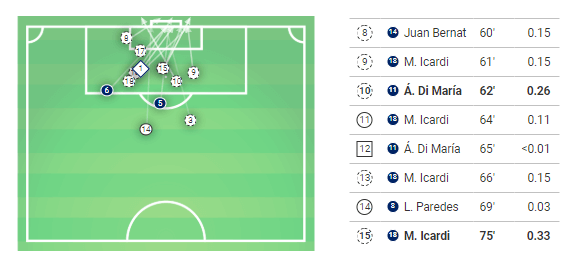
During most of their attacking situations, PSG attackers usually sat on the shoulder of defenders and waited for through balls to be made towards their run. The situation below was an example which showed how Icardi’s movement pinned down Dijon’s defenders. This created a huge pocket of space for Di María to enter the final third and picked up the clearance in case the pass was intercepted.
In this scenario, Ngonda wasn’t able to move out from his position as it allowed the Inter loanee to move into Ecuélé Manga’s blindside. Meanwhile, the former Cardiff defender himself also couldn’t drop his place since Icardi would have enough space to approach the box. Therefore, when he cleared the ball, Di María was free to receive the ball and made a through pass into Mbappé’s run.
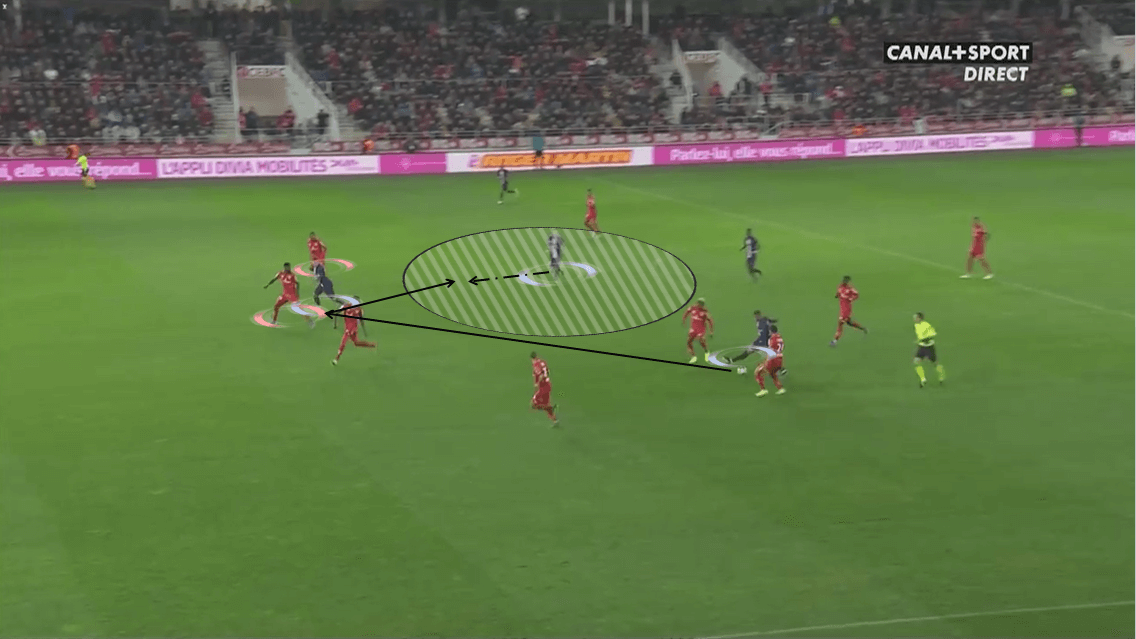
Defensively, PSG set their shape up in a 4-1-4-1 formation with Bernat and Gueye pushed higher up the pitch to join up with the wingers. They formed two defensive lines and stretched wide more often to cover the gap out wide. At the same time, Paredes was positioned in between the lines as he was responsible for limiting the gap that Dijon attackers could capitalise.
The visitors also didn’t hesitate to push their shape higher to allow the attackers to disrupt the opposition’s build-up. With at least three attackers involving in the pressing process, it was possible for PSG to create a man-oriented press and left the far full-back unmarked. In the meantime, recovering possession was a must as they aimed to create a quick counter-attack inside Dijon’s half using pacey players.
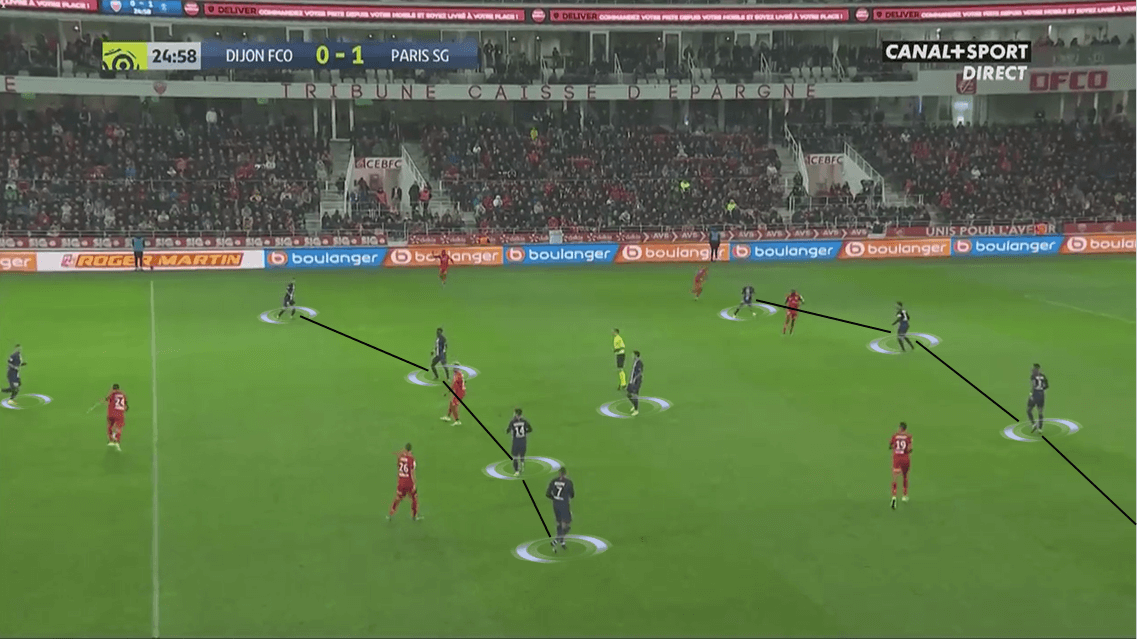
While keeping their shape wide was an efficient strategy to prevent Dijon from distributing the ball to both wings more often, they still left space unoccupied for several players to capitalise. PSG players had the tendency of roaming from their positions to join their teammates in tackling the ball away from the ball carrier, similar to the situation below.
The visitors had three players surrounded Chouiar in order to recover possession for the team, including Dagba who dropped his right-back position to close Dijon’s winger down. The young defender left a huge gap behind his back and Ndong acknowledged that to move into while picking up the through ball from Chouiar at the same time. These type of situations led to dangerous counter-attacks being created by Dijon players and some even threaten Navas’ goal.
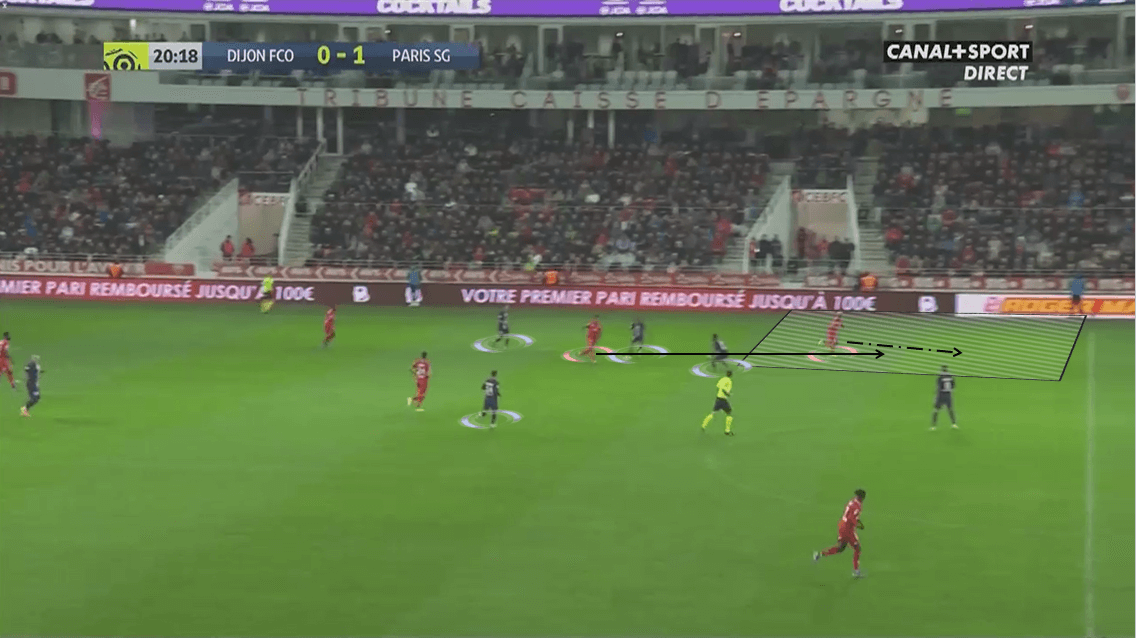
Conclusion
It is fair to say that Dijon had caused a huge upset as they secured all three points against the top team on the league table in Paris Saint-Germain. While Jobard’s side did have a good game in terms of tactical discipline and capitalised errors to create chances, PSG also had a match to forget.
Tuchel’s side enjoyed a much dominant spell during the match, which was demonstrated in their stats. But, just a few minutes of dropping their performance between both halves cost them three points that could have extended their lead at the top. While the top spot is still theirs after this matchday, they are showing weaknesses in their tactics which other teams could exploit. It is important that Tuchel sits back and analyses what went wrong for his team and thinks of a solution to fix those problems.

If you love tactical analysis, then you’ll love the digital magazines from totalfootballanalysis.com – a guaranteed 100+ pages of pure tactical analysis covering topics from the Premier League, Serie A, La Liga, Bundesliga and many, many more. Buy your copy of the November issue for just ₤4.99 here




Comments